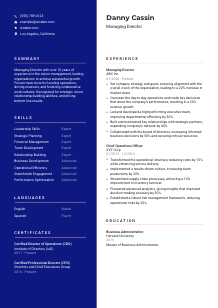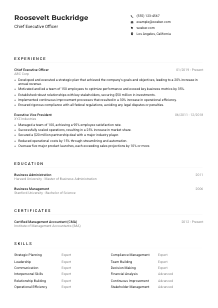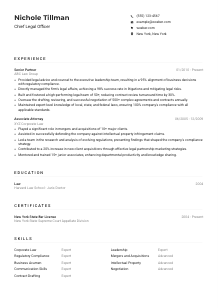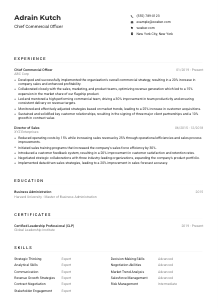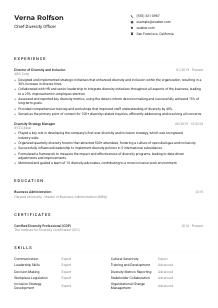Managing Director Resume Example
Steering companies but feeling directionless with your resume? Navigate this Managing Director resume example, mapped out with Wozber free resume builder. Grasp how you can orchestrate your executive expertise to resonate with boardroom expectations, charting a professional course that sets you apart at the helm!

How to write a Managing Director Resume?
As a Managing Director in the making, your journey to the top demands a resume as distinguished and strategic as your vision for any enterprise you aim to lead. This isn't just about listing achievements; it's about crafting a narrative that positions you as the linchpin for future successes. With Wozber's free resume builder, creating an ATS-compliant resume tailored to the unique landscape of executive leadership is seamless.
Through this guide, let's tailor your expertise into a managing director resume that not only meets but exceeds boardroom expectations. Ready to captain your career to new horizons?
Personal Details
The Personal Details section is the cornerstone of your professional introduction. Ensuring precision here sets a confident tone for the narrative that follows. Let's tailor this section to embody the stature of a Managing Director role.
1. Brand Yourself with Your Name
Think of your name as the headline of your professional epic. Ensure it's boldly presented, utilizing a clear font that commands attention. This is your first handshake with the reader; make it firm and memorable.
2. Reflect the Sought-after Role
Immediately beneath your name, assert your ambition by aligning with the job title. Mimicking the exact title, 'Managing Director', as listed in the job description, instantly clarifies your career objectives and aligns your aspirations with employer expectations.
3. Prioritize Essential Contact Methods
List your most reliable contact information, emphasizing a professional email format, and your direct phone number. Ensure no detail is overlooked, as even a single typo could sever this crucial connection.
4. Enforce Your Local Advantage
Being situated in the demanded location, 'Los Angeles, California', provides you with an implicit advantage. Clearly indicating your location not only confirms your logistical suitability but also situates you within the business ecosystem of the role.
5. Professional Websites: To Include or Not?
If having a LinkedIn profile or a personal portfolio website that reflects your professional narrative, make sure these are included. However, ensure they are scrupulously updated to mirror the accomplishments and skill set laid out in your resume.
Takeaway
Approach the Personal Details section as your initial pitch to the boardroom. This isn't merely an informational segment; it's an exercise in branding, clarity, and professional alignment. Keep it concise, ensure it's error-free, and directly reflect how you want to be perceived as a Managing Director candidate.





Experience
The Experience section is where you articulate your strategic impact on enterprises, translating your past leadership into a compelling case for your future roles. Let's dive deep into structuring this narrative to spotlight your executive prowess.
- Set company strategy and goals, ensuring alignment with the overall vision of the organization, leading to a 20% increase in market share.
- Overseen the day‑to‑day operations and made key decisions that drove the company's performance, resulting in a 25% revenue growth.
- Led and developed a high‑performing executive team, improving departmental efficiency by 30%.
- Built and maintained key relationships with strategic partners, expanding company's network by 40%.
- Collaborated with the board of directors, increasing informed business decisions by 50% and securing critical resources.
- Transformed the operational structure, reducing costs by 15% while enhancing service delivery.
- Implemented a results‑driven culture, increasing team productivity by 20%.
- Streamlined supply chain processes, achieving a 10% improvement in inventory turnover.
- Pioneered advanced analytics, giving insights that improved decision‑making accuracy by 30%.
- Established a robust risk management framework, reducing operational risks by 25%.
1. Dissect the Job Description
Before you begin, break down the job posting to understand the employer's priorities: strategic planning, revenue growth, operational scale, and leadership. These become the pillars around which your experience narratives are structured.
2. Chronology and Clarity
Frame your professional journey starting with your most recent role, ensuring each position listed encapsulates your title, tenure, and the company's name. This not only speaks to your trajectory but also to your growth and the contexts you have thrived in.
3. Spotlight Your Achievements
Each role you list must be a testament to your capability to lead, innovate, and grow an organization. Mirror the requirements of the Managing Director role by citing specific outcomes like 'leading to a 20% increase in market share' or 'resulting in a 25% revenue growth'. Quantifying these accomplishments provides tangible proof of your executive caliber.
4. Quantify, Then Quantify Some More
Numbers tell a compelling story. By quantifying your successes (e.g., revenue growth percentages, efficiency improvements), you not only affirm your claims but also provide a clear metric for your impact.
5. Relevance Is King
Keep your experience laser-focused on what matters for a Managing Director. Extraneous achievements, however impressive, will dilute the potency of your application. Always align your narrative with the strategic needs of the role.
Takeaway
The Experience section is your platform to showcase not just where you've been, but how you've left each place better than you found it. It's about articulating a trajectory of impact that firmly places you in the realm of strategic executive leadership. Craft each statement with the intent to demonstrate not only your fit for the role but your readiness to elevate the company to new heights.
Education
In the realm of executive roles, your educational background lays the foundation of your understanding of the complex business world. Presenting your Education with strategic intent reinforces your capacity to lead at a high level.
1. Highlight Requisite Degrees
Your education should directly respond to the job requirements. In listing a 'Master of Business Administration in Business Administration', you not only fulfill the preferred criteria but also underscore your commitment to an advanced understanding of business mechanics.
2. Structure for Clarity
Maintain a crisp, clear listing of your degrees, ensuring to include the field of study, the degree obtained, the educational institution, and the graduation year. This straightforward presentation respects the reader's time and highlights essential information effortlessly.
3. Degree as a Dialogue
If your degree specifically aligns with the job's requirements, it's not merely an educational achievement; it's a direct dialogue with the prerequisites of the role. Make sure your education speaks directly to the demands of a Managing Director position, as in the provided example.
4. Coursework and Beyond
For those closer to the beginning of their career or with particularly relevant coursework, delineating specific classes or projects can add depth to your educational narrative. For senior roles, this detail might be superfluous but consider its potential to supplement your qualifications.
5. Showcase Continuous Learning
Beyond degrees, highlighting continued education, whether through formal certifications or executive courses, signals a commitment to staying at the forefront of business practices and leadership strategies.
Takeaway
Your Education section should serve as a bastion of your readiness and alignment with the intellectual demands of a Managing Director. It's not just about listing degrees; it's about substantiating your capacity to navigate complex business environments and lead with insight.
Certificates
In the ever-evolving business landscape, certifications act as markers of specialized knowledge and a commitment to continuous professional development. For a Managing Director, they underscore a dedication to excellence.
1. Identify and Align With Job Requirements
First, pinpoint certifications explicitly mentioned or implied as beneficial in the job posting. Certifications like 'Certified Director of Operations' or 'Certified Professional Director' directly respond to the job's preference for verifiable expertise.
2. Choose Pertinent Certifications
The selection of certifications to include should be highly strategic, focusing on those that augment your authoritative understanding of business operations and leadership philosophies. Less relevant certifications can be omitted to keep the focus sharp.
3. Clear and Current Credentials
Be explicit about the dates of acquisition for your certifications, especially if they have expiration dates. This transparency ensures your credentials are perceived as current and valid.
4. Embrace a Culture of Learning
In the context of your career progression, certifications are not just accolades but testimonials of your ongoing journey to broaden your perspective and skillset. Showcasing recent or relevant certifications demonstrates an admirable ethos of self-improvement.
Takeaway
Your Certificates section is a testament to your proactive approach to professional growth. Positioned correctly, it supports your narrative as a Managing Director, reinforcing your suitability with tangible evidence of specialized leadership training.
Skills
Your Skills section is a strategic snapshot of your professional arsenal. Here, precision and relevance are key. Let's align your skills with the expressed needs of a Managing Director, curating a list that speaks directly to your capability to excel.
1. Extrapolating From the Job Description
Begin with a deep dive into the job listing, identifying both the explicit and implicit skills required. Leadership, strategic planning, and financial management are not just desirable; they're indispensable for a Managing Director.
2. Tailoring Your Toolkit
Direct alignment with the job's needs elevates your resume. List skills that resonate with the role, like 'Leadership Skills', 'Strategic Planning', and 'Financial Management'. This tailored approach demonstrates a bespoke fit for the position.
3. Order and Organization
Rather than inundating with every skill you possess, prioritize those most pertinent to a Managing Director's role. This curated approach allows for a cleaner presentation that highlights your top proficiencies.
Takeaway
In the boardroom, every decision, every strategy, and every success hinges on the adeptness of the leadership. Your Skills section must reflect the acumen needed to navigate this echelon of responsibility. A carefully tailored list of skills promises a trajectory of impactful leadership and strategic foresight.
Languages
In an increasingly globalized business landscape, linguistic prowess can be more than just a skill—it can be an asset. For a Managing Director role, particularly in multinational contexts, the ability to communicate across cultural and linguistic barriers is invaluable.
1. Job Description as Your Guide
First, verify if any specific languages are listed as requirements. In our guiding job description, 'ability to effectively communicate in English is a prerequisite.' This lays the primary linguistic foundation for the role.
2. Prioritizing Language Proficiencies
Start with the language(s) most critical to the role, indicating your level of fluency. For roles requiring international interaction, fluency in additional languages like Spanish can set you apart.
3. Listing Additional Languages
While the primary focus should be on the required languages, showcasing additional linguistic capabilities can illustrate your readiness for global engagement.
4. Clarity in Language Proficiency
Accurately describe your level of proficiency in each language, using terms like 'native', 'fluent', or 'basic'. This honesty ensures expectations are matched from the outset.
5. Understanding the Role's Global Aspect
Evaluate the role's scope for international exposure. For a Managing Director, the ability to engage with diverse teams and stakeholders around the globe can be a significant advantage.
Takeaway
Your linguistic skills are not merely an addition to your resume; they symbolize your capacity to lead and communicate in an increasingly interconnected world. Highlighting these skills effectively signifies your readiness for the global stage, making you a compelling candidate for the role of a Managing Director.
Summary
The Summary is your opening argument, your opportunity to succinctly argue why you're the ideal candidate for the Managing Director position. Let's refine it to not just introduce you but to distinguish you right from the outset.
1. Decode the Job Essence
Start by internalizing the job posting, understanding what the core demands and aspirations of the role are. This initial step allows you to reflect these elements in your summary, making your opening statement resonate with the job requirements.
2. Establish Your Professional Identity
Begin with a statement that encapsulates your career and impact: 'Managing Director with over 10 years of experience in senior management, leading organizations to achieve substantial growth.' This not only states your qualification but reflects a trajectory of success.
3. Highlight Your Unique Contributions
Elaborate on a few key achievements and skills that position you uniquely for the role. Matching accomplishments with the job's demands, like 'scaling operations and driving revenue', immediately illustrates your capacity to deliver.
4. Brevity with Impact
Your summary should be potent, concise, and vibrant, encapsulating your essence in a few impactful lines. Aim for a balanced blend of professional achievements and your strategic vision as a leader.
Takeaway
Your summary isn't just a blurb; it's a powerful preamble that sets the tone for your resume. By articulating your professional narrative with coherence and conviction, you invite the reader into a story of a seasoned, strategically minded leader ready to steer their company towards new achievements. This finely honed introduction sets the stage for the detailed accomplishments and qualifications that follow.
Charting Your Course as a Managing Director
Navigating through the creation of a Managing Director resume with precision and intent is the first step in your journey toward leadership excellence. Remember, it's not just about fitting a template; it's about tailoring your storied career into a compelling narrative that positions you at the helm. With Wozber's free resume builder, including ATS-compliant resume creation tools and an ATS-friendly resume format, the path to crafting your career masterpiece is clear. Align your experience, education, and skills with strategic precision, and embark on the voyage toward your next executive role with confidence.

- Bachelor's degree in Business, Finance, or a related field.
- MBA or Master's degree preferred.
- Minimum of 10 years of senior management or executive experience, preferably in the same industry as the company.
- Proven track record of successfully scaling operations and driving substantial revenue growth.
- Excellent interpersonal and leadership skills, with the ability to foster a collaborative and inclusive work culture.
- Relevant certification such as Certified Director of Operations (CDO) or Certified Professional Director (CPD) is a plus.
- Ability to effectively communicate in English is a prerequisite.
- Must be located in Los Angeles, California.
- Set company strategy and goals, ensuring alignment with the overall vision of the organization.
- Oversee the day-to-day operations and make key decisions to drive the company's performance and growth.
- Lead, mentor, and develop a high-performing executive team, and provide strategic guidance to department heads.
- Build and maintain relationships with key partners, stakeholders, and potential clients.
- Collaborate with the board of directors to make informed business decisions and secure necessary resources.







